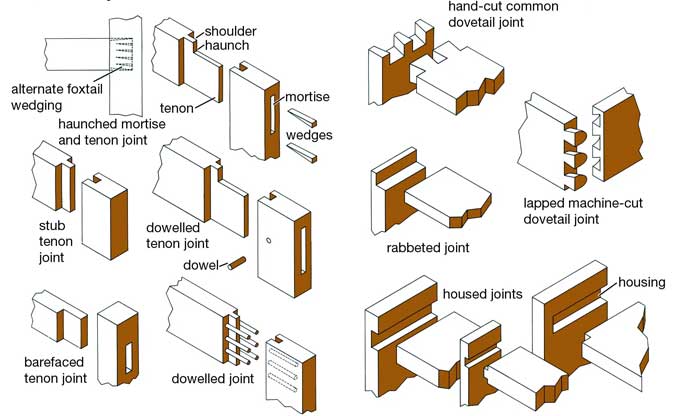
Types of Wood Joints used in a field of Construction

Creating complex objects from wood requires the joining of wood pieces.
Wood joints can be created using a variety of other techniques, depending on the type of joint. It is sometimes necessary to carve a channel into two pieces of wood for a joint to stay together, while in other cases, fasteners such as nails or screws work.
Woodworkers are able to choose from many different types of woodworking joints when making furniture, flooring, and other items made of wood. The woodworker is thus provided with a variety of creative options.
Varieties of Wood Joints
There are a few types of wood joints that are used for different construction purposes. Some of the different types of wood joints are described below:
Miter Joints
Miter cuts refer to two 45-degree cuts on two pieces of wood that meet to make a 90-degree angle.
Door frames, window frames, and picture frames often have miter joints at their visible outer corners. Due to their larger surface area, they are stronger than butt joints, but they still require glue and mechanical fasteners to remain secure.
It has the advantage of being solid and seamless without showing end grains at the corner.
Groove and Tongue Joints
Among the most popular woodworking joints is the tongue and groove joint, which can be found in flooring, parquet, paneling, and other wood products.
One piece of wood has a groove or channel, while the other has a tongue or ridge. Joints are made strong by sliding the tongue into the groove. In wood flooring and similar components, these joints are typically seen on flat surfaces.
Dado Joint
Dado joinery looks similar to tongue-and-groove wood joints. Dadoes are cut across the grain of the wood, whereas grooves are cut along it, usually along the length of the board.
As well, the edges are not carved with tongues but rather with wider grooves that fit the thickness of the other piece. Shelves and bookshelves are the most common uses of Dado's joints.
Butt Joint
In terms of wood joints, butt joints are the most basic. Timber boards have a "butt" at the end thus it is called butt joints By joining two squared-off pieces of wood at a right angle, it is the simplest and weakest joint in woodworking.
At the butt joint, mechanical fasteners such as nails, screws, glue, or dowels are used instead of nails, screws, glue, or dowels.
You may see butt joints around baseboards and window trims in construction projects, and these joints are a great option when it comes to speeding up the construction process at the expense of the appearance.
Finger Joints
A finger joint, also known as the box junction or the box junction joint, is one of the most common woodworking joints. Wood joinery of this type is used to create a longer board by joining two pieces of wood together. Dovetail joints have angled pins, while finger joints have square pins.
Dovetail joints rely on mechanical strength to hold their joints together, but finger joints rely on the glue.
Dovetail Joints
There is a great deal of tensile strength and resilience in this woodworking joint. It cannot be pulled apart easily. There are several trapezoidal-shaped pins and tails interlocking with one another.
They are used most often to construct drawers because of their resistance to being pulled apart. There are no mechanical fasteners needed when a joint is glued since it is permanent.
Biscuit Joints
Joints like this are reinforced versions of oval-shaped butt joints. Wood is compressed and dried to make biscuits. The timber piece is carved with grooves on both ends that hold a thin wafer that serves as a connector. The glue will expand the insert to cover the carving tool's left over space after it has been applied.
Using this joint, a flush surface is achieved since the joint completely disappears. The mortises for biscuit joiners were cut incorrectly and the alignment was imperfect in this joint.
To learn more, watch the following video tutorial.
Video Source: Eric Brennan
Mortise and Tenon Joints
Joinery using mortise and tenon is still one of the strongest types of jointly used in framing and construction. This is commonly used to connect two pieces of wood at 90 degrees; one end of the piece (Tenon) is inserted into the other piece's hole (mortise).
A pin or wedge can be used after the glue has dried in order to secure the joint after it has been held together with glue. Compared to a butt joint, it is much stronger and a much more sophisticated alternative.
Half-Lap Joint
Two pieces of wood are joined together by cutting their overlapped ends down to half their thickness. Because they maintain consistent thickness, half-lap joints are stronger than butt joints.
Connections in the middle of wood are usually made with this type of connector. In both the manufacture of furniture and in framing, half-lap joints are often used as a method of joining wood together.
Rabbet Joint
In order to create this type of joint, a recess is carved into the edge of the timber. In this case, only one side has been cut, in contrast to the protruding edge of a tongue-and-groove joint. Even though it is a simple wood joint, rabbet joinery is much more durable than butt joinery.
It is most often used to disguise a corner's "end grain" or to recess a cabinet back into the sides using rabbet joints. Rabbet joints are most frequently used to reduce the visibility of "end grain" at corner joints or recess cabinets again. Since it has a larger surface area, a Double Rabbet provides the best joint strength.


